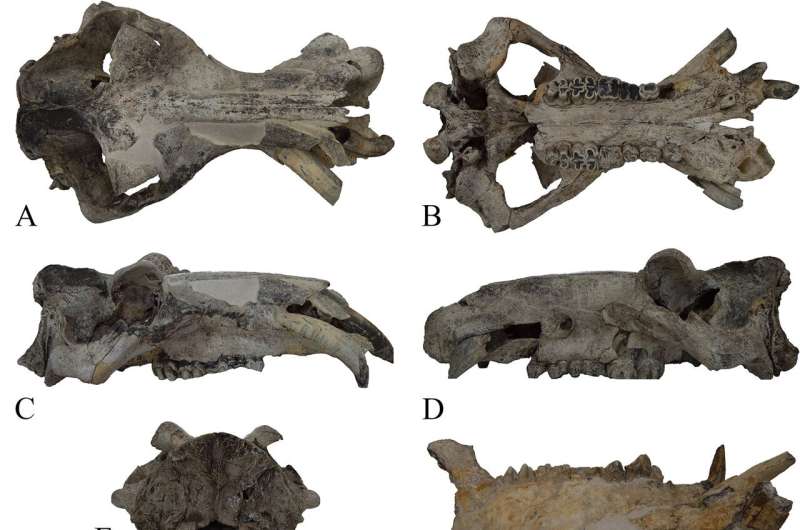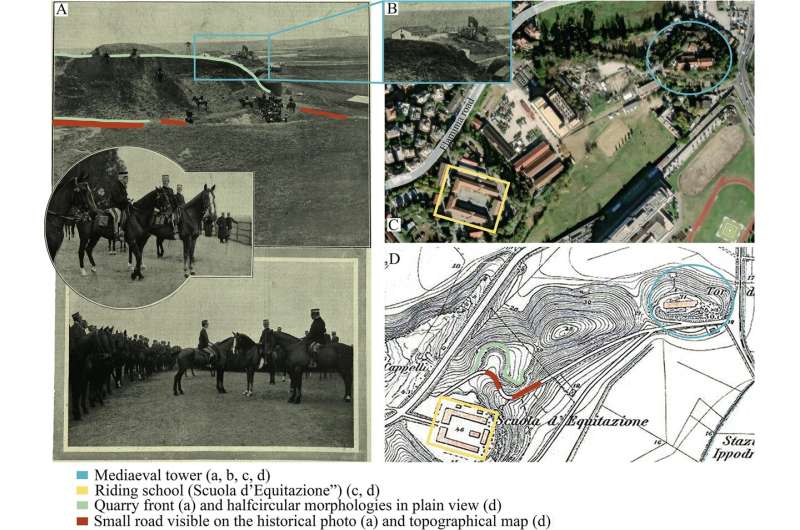
The skull of Hippopotamus amphibius of Cava Montanari. Cranium in dorsal (A), ventral (B), right lateral (C), left lateral (D) and posterior (E) views. Mandible in occlusal (F) right lateral (G) and left lateral (H) views. Scale bar 10 cm. Credit: Mecozzi et al., 2023, PLOS ONE, CC-BY 4.0 (creativecommons.org/licenses/by/4.0/)
Modern hippos first dispersed in Europe during the Middle Pleistocene, according to a study published Nov. 22, 2023 in the open-access journal PLOS ONE by Beniamino Mecozzi of the Sapienza University of Rome and colleagues.
Modern hippos, Hippopotamus amphibius, arose from African ancestors during the Quaternary, a time when hippos were widespread in Europe. However, the details of the modern species’ origin and dispersal into Europe are unclear and highly debated.
In this study, Mecozzi and colleagues provide new insights via analysis of a fossil hippo skull from the study area of Tor di Quinto in Rome.
The skull of Tor di Quinto, currently housed at the Earth Science University Museum of Sapienza University of Rome, is among the most complete hippo specimens known from Pleistocene Europe, but its significance has been unclear due to uncertainties about its age and where exactly it was originally excavated.
Following restoration of the skull in 2021, researchers were able to analyze the composition of sediments found within the skull cavities, revealing a match to the local Valle Guilia Formation, indicating a geologic age for this skull between 560,000–460,000 years old. Cranial and dental morphologies also confirmed the identity of this skull as the modern species Hippopotamus amphibius.

Historical picture of the Tor di Quinto area from the archive of the Istituto Superiore per la Protezione e la Ricerca Ambientale (ISPRA, A, B) and the same area today. Credit: Mecozzi et al., 2023, PLOS ONE, CC-BY 4.0 (creativecommons.org/licenses/by/4.0/)
This research reveals this skull to be the oldest known fossil of this modern hippo species in Europe. These results shed light on the history of hippos in Europe, reinforcing the hypothesis of an early dispersal during the Middle Pleistocene and bolstering broader understanding of the deep history of these large mammals.
Hippos are highly influential species within modern and ancient ecosystems, and they are valuable indicators of past climate and environmental conditions.
The authors add, “Restoring the mammal skeletons exposed at the University Museum of Earth Science, Terra, Sapienza University of Rome offers new data for old fossils. The multidisciplinary study of the skull from Cava Montanari (Roma) redefines the first dispersal of Hippopotamus amphibius in Europe.”
More information:
Reinforcing the idea of an early dispersal of Hippopotamus amphibius in Europe: Restoration and multidisciplinary study of the skull from the Middle Pleistocene of Cava Montanari (Rome, central Italy), PLoS ONE (2023). DOI: 10.1371/journal.pone.0293405. journals.plos.org/plosone/arti … journal.pone.0293405
Citation:
Earliest known European common hippopotamus fossil reveals their Middle Pleistocene dispersal (2023, November 22)
retrieved 22 November 2023
from https://phys.org/news/2023-11-earliest-european-common-hippopotamus-fossil.html
This document is subject to copyright. Apart from any fair dealing for the purpose of private study or research, no
part may be reproduced without the written permission. The content is provided for information purposes only.
>>> Read full article>>>
Copyright for syndicated content belongs to the linked Source : Phys.org – https://phys.org/news/2023-11-earliest-european-common-hippopotamus-fossil.html










